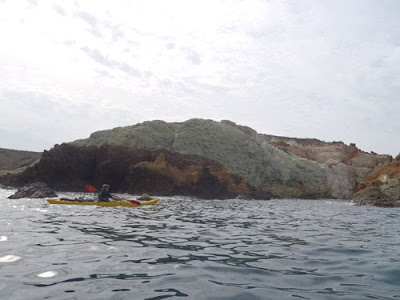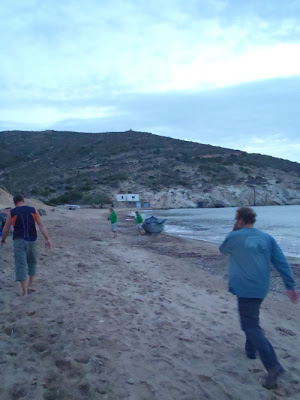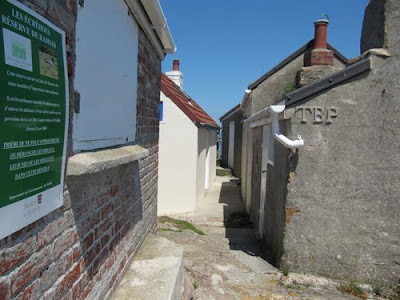Milos West Coast
After two relatively easy days along the east and north coasts it was clear that the weather was on the turn. Early morning rain and strong winds hinted at more challenging kayaking conditions, particularly was we were heading out towards the more exposed west coast.
By 09.30 though conditions were more settled and we were able to take advantage of a lull in the wind to head across the entrance to Milos harbour towards Cape Vani.
Although the weather did deteriorate later in the day by then we were safely ashore but more importantly we were in a position that one more good day would mean that we should be able to complete the circumnavigation of Milos one day earlier than planned.
By 09.30 though conditions were more settled and we were able to take advantage of a lull in the wind to head across the entrance to Milos harbour towards Cape Vani.
Although the weather did deteriorate later in the day by then we were safely ashore but more importantly we were in a position that one more good day would mean that we should be able to complete the circumnavigation of Milos one day earlier than planned.
 Approaching Cape Vani, the north west tip of the island. The cliffs are in this area are spectacular.
Approaching Cape Vani, the north west tip of the island. The cliffs are in this area are spectacular. A brief stop was made at the old manganese mine just before Cape Vani. There were plenty of ruins to explore.
A brief stop was made at the old manganese mine just before Cape Vani. There were plenty of ruins to explore. Manganese Mine. The first ore was extracted in 1898 and it is peak there were 250 people employed at the mine. In total 220,000 tones were extracted with the mine finally closing in 1928.
Manganese Mine. The first ore was extracted in 1898 and it is peak there were 250 people employed at the mine. In total 220,000 tones were extracted with the mine finally closing in 1928. The beach at the mine was a rich source of driftwood which was going to come in really useful later in the day.
The beach at the mine was a rich source of driftwood which was going to come in really useful later in the day. Chris and Shirley loaded with wood off the west coast of the island. The island behind is Antimilos, which is high on my list of places to paddle to.
Chris and Shirley loaded with wood off the west coast of the island. The island behind is Antimilos, which is high on my list of places to paddle to. The complex geology of Milos creates a fascinating backdrop to the kayaking. Alternate bands of rock produce a colourful coastline. This is heading south along the west coast of Milos.
The complex geology of Milos creates a fascinating backdrop to the kayaking. Alternate bands of rock produce a colourful coastline. This is heading south along the west coast of Milos. We had planned to reach the south west corner of the islands but a rapidly increasing wind forced an early finish at Agios Ioannis. This was fortunate as the wind increased in strength very quickly creating challenging kayaking conditions. We were ashore by this time.
We had planned to reach the south west corner of the islands but a rapidly increasing wind forced an early finish at Agios Ioannis. This was fortunate as the wind increased in strength very quickly creating challenging kayaking conditions. We were ashore by this time. Strong gusts of winds blasting off the surrounding high land created problems for the tents despite to use of extra pegs and heavy stones. This is one tent being recovered from the sea.
Strong gusts of winds blasting off the surrounding high land created problems for the tents despite to use of extra pegs and heavy stones. This is one tent being recovered from the sea. When on a kayaking trip always try to take a chef with you. Gary was able to produce delicious meals for 30 people in no time at all. The driftwood from the manganese mine was particularly useful.
When on a kayaking trip always try to take a chef with you. Gary was able to produce delicious meals for 30 people in no time at all. The driftwood from the manganese mine was particularly useful.










































